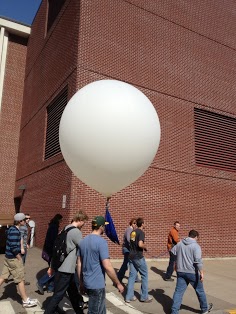Throughout my college career, I have used various GPS devices for navigation and data collection. However, I had previously never created a geodatabase to be deployed in the field to be used for data collection. This report will summarize the process of developing a data collection procedure from the ground up. This process begins with creating a geodatabase and feature classes. Domains will be set for the feature classes to aid in the data collection process in the field. Finally, the geodatabase will be saved to a Trimble Juno GPS unit for data collection.
 |
| Figure 1. Trimble Juno to be used to collect GPS data |
This weeks assignment consisting of ArcPad data collection took place at the Priory. This land, purchased by the university to be a day care facility, is located to the south of the city of Eau Claire. Figure 2 shows the mostly wooded areas surrounding the building that we have previously used for navigation exercises.
 |
| Figure 2. Study Area |
Methods
My group began this assignment by considering the terrain and features at the priory that we could collect multiple attributes for. We decided to mark the locations we found garbage and signs at the priory. The next step was to build a geodatabase containing the features and attributes that would be collected. A new geodatabase was created, as well as "Garbage" and "Signs" feature classes. The Garbage feature class contained garbage material, garbage size, garbage type, and notes fields, and the Signs feature class had sign color, sign material, sign type, and notes. To aid in the data collection process, domains were created to allow us to simply select a predetermined option rather than having to type in each attribute. Once the feature classes were created and the domains were set, their symbology was changed so that they could be differentiated on the Juno when we were out in the field. The features and an aerial image were added to a blank ArcMap document, and then saved to the Juno using the ArcPad Data Manager toolbar.
Once the was saved on the Juno, we were able to go out in the field and begin to collect data using ArcPad. My group began in the parking lot marking the locations of signs and garbage as it was found. We then moved to the north and followed a trail where trail marker signs were mapped. Figure 3 shows the route the we took, as well as the locations of all signs and garbage.
 |
| Figure 3. Locations of Signs and Garbage at the Priory |
After the data collection, the data was extracted from the Juno by simply copying and pasting the folder back into the Priory folder that I had previously created on the computer. I examined the data, and then created a series of maps to symbolize the different attributes that we collected.
Discussion
Having already created the domains for each feature, the data collection was seamless and went very well. We were able to select from a preset list of options for each attribute which allowed the collection to be very quick and efficient. The only exception was when the garbage or sign had an attribute that was not part of the domain. When this occurred, the "other" option was selected and the attributed was specified in the notes field. Figures 4, 5, and 6 display the garbage material, type, and size of items that were found at the priory. Most of the garbage items found were plastic bottles, aluminum cans, and plastic bags. These items were all found near the parking lot for the priory, which makes sense because it is the area where people are the most.
 |
| Figure 4. Garbage Material |
 |
| Figure 5. Garbage Types |
 |
| Figure 6. Garbage Size |
 |
| Figure 7. Sign Type |
 |
| Figure 8. Sign Color |
 |
| Figure 9. Sign Material |






